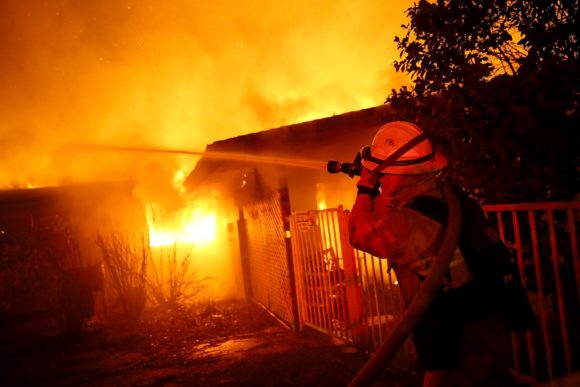On Oct. 8, 2017, sparks from private electric equipment set fire to the dry hills of Northern California’s wine country, but it was only once the flames jumped from the grasslands to densely packed Santa Rosa that the destruction intensified. By the time the Tubbs Fire was fully contained, it had consumed some 5,600 buildings, making it the most destructive in California history.
A year later, transmission lines owned by PG&E Corp. ignited brush in rural Butte County and caused the Camp Fire, which quickly spread into the community of Paradise. By the time it had been controlled, nearly 19,000 structures had been destroyed, easily superseding the damage from Tubbs.
These fires showed how vulnerable suburban communities are in an era when climate change is causing more extreme heat and dryness. And yet as they rebuild, many homeowners in these communities are repeating the mistakes that caused such historic levels of destruction.
That’s the finding of a survey released Monday by the Insurance Institute for Business & Home Safety, an industry-supported research non-profit. While wildfire managers have historically focused on the wildland urban interface, or WUI, where towns meet flammable vegetation, one clear lesson of the Tubbs and Camp fires is that suburban communities—even those not in zones labeled high risk—need to take a more defensive approach to fire.
“A critical step in defending against the wildfire threat faced by communities is to build back better than before,” the report states. “Unfortunately, we have already seen missteps taking place.”
Fire risk in the U.S. has been steadily growing in scope and intensity as climate change has created more arid conditions. About 5.7 million acres have been consumed each year by wildfires since the 1990s, according to Verisk Analytics, a data analytics firm. But that number has been growing steadily. In just the last half-decade, an average of 7.8 million acres have burned each year.
IBHS based its analysis on a variety of sources, including an on-the-ground post disaster inspection of the Camp Fire site and lab-based experiments on ignition. In particular, IBHS found that wood fences and patios acted as conduits for fire, while houses that had metal fencing were less likely to ignite. Similarly, homes that cleared a five-foot perimeter of vegetation also did better than those with close-up landscaping.
Despite the obviousness of such steps, many homeowners won’t take them unless they’re required to by law, says Daniel Gorham, a research engineer with IBHS and a co-author of the report. The reports singles out Coffey Park in Santa Rosa as an example of communities returning to dangerous but more aesthetically pleasing practices. The enclave was razed almost to the ground by the fire, but since the area doesn’t fall into the “most severe” fire risk zone on government maps, residents aren’t required to follow the most stringent fire codes. The result, IBHS says, has been rebuilding that includes the same deadly fire traps.
“We understand that there was a need for rush to build back housing,” Gorham says. But he also urges homeowners to follow common sense safety practices even when they’re not mandatory. “If you don’t want to tear down your whole fence,” he adds, “at least make the five feet closest to your house metal.”
The expanding understanding of how official maps underpredict fire risk echoes the crisis that’s been building in the country around flood risk. A recent study found that the government has underestimated the numbers of properties at risk for severe flooding by 70%, equivalent to 6 million homes. All of those are likely underinsured.
The IBHS report indicates that a smaller but parallel problem is developing in fire zones. Michael Wara, director of the Climate and Energy Policy Program at Stanford University, says of IBHS’s analysis, “This is one of the first places I’ve seen to emphasis that wildfire resilience is a problem not in the WUI but in the suburbs.”
“We need to think much more expansively about the areas that we are hardening to fire risk,” Wara adds, “even if they are not in severe fire risk zones.”
Was this article valuable?
Here are more articles you may enjoy.


 ‘Dream Is in Sight:’ Chamber, Reinsurers, Insurers Urge Florida to Stay the Course
‘Dream Is in Sight:’ Chamber, Reinsurers, Insurers Urge Florida to Stay the Course  Zillow Deleting Climate Risk Scores Reveals Limits of Flood, Fire Data
Zillow Deleting Climate Risk Scores Reveals Limits of Flood, Fire Data  Abbott Presses Congress for Shield Over Preemie Baby Formula Litigation That Could Cost It Billions
Abbott Presses Congress for Shield Over Preemie Baby Formula Litigation That Could Cost It Billions  NYT, Chicago Tribune Sue Perplexity AI as Copyright War Rages On
NYT, Chicago Tribune Sue Perplexity AI as Copyright War Rages On 